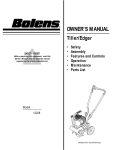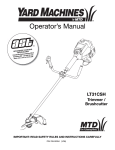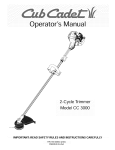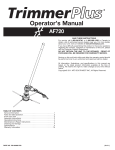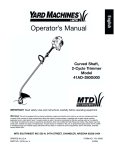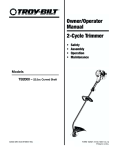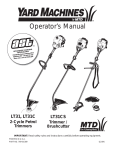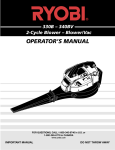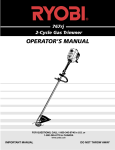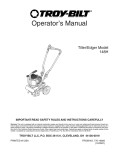Download Yard-Man LT31 Trimmer User Manual
Transcript
Operator’s Manual LT31 2-Cycle Petrol Trimmer IMPORTANT: Read safety rules and instructions carefully before operating equipment. PRINTED IN U.S.A. PART NO. 769-00828 (9/03) TABLE OF CONTENTS Content Page Important Safe Operation Practices............................................................... 3 Know Your Trimmer ........................................................................................ 6 Assembling Your Trimmer............................................................................... 7 Operating Your Trimmer.................................................................................. 8 Maintaining Your Trimmer ............................................................................. 11 Off-Season Storage ...................................................................................... 16 Troubleshooting ............................................................................................ 17 Specifications ............................................................................................... 18 FINDING MODEL NUMBER This Operator’s Manual is an important part of your new trimmer. It will help you assemble, prepare and maintain the unit for best performance. Please read and understand what it says. Before you start assembling your new equipment, please locate the model plate on the unit and copy the information from it to the space provided below. The information on the model plate is very important if you need help from our Customer Support Department or an authorized dealer. • Locate the model number on the engine next to the shroud. A sample model plate is explained below. For future reference, please copy the model number and the serial number of the equipment in the space below. MODEL : S/N : Copy the model and parent part number here: ITEM : Copy the serial number here: 2 SECTION 1: IMPORTANT SAFE OPERATION PRACTICES This Symbol Points Out Important Safety Information Which, If Not Followed, Could Endanger The Personal Safety And/or Property Of Yourself And Others. Read And Follow All Instructions In This Manual Before Attempting To Operate Your Cultivator. FailureTo Comply With These Instructions May Result In Personal Injury. When You See This Symbol–Heed Its Warning. SAFETY ALERT SYMBOL: Indicates danger, warning, or caution. Attention is required in order to avoid serious personal injury. May be used in conjunction with other symbols or pictographs. NOTE: Advises you of information or instructions vital to the operation or maintenance of the equipment. DANGER: Failure to obey a safety warning will result in serious injury to yourself or to others. Always follow the safety precautions to reduce the risk of fire, electric shock, and personal injury. WARNING: Failure to obey a safety warning can result in injury to yourself and others. Always follow the safety precautions to reduce the risk of fire, electric shock, and personal injury. CAUTION: Failure to obey a safety warning may result in property damage or personal injury to yourself or to others. Always follow the safety precautions to reduce the risk of fire, electric shock, and personal injury. • READ ALL INSTRUCTIONS BEFORE OPERATING • • • • • • • • • Read the instructions carefully. Be familiar with the controls and proper use of the unit. Do not operate this unit when tired, ill or under the influence of alcohol, drugs or medication. Children under the age of 15 must not use the unit; teens can use the unit under adult guidance. Inspect the unit before use. Replace damaged parts. Check for petrol leaks. Make sure all fasteners are in place and secure. Replace cutting head parts that are cracked, chipped, or damaged in any way. Make sure the cutting head is properly installed and securely fastened. Be sure the cutting head guard is properly attached, and positioned as recommended. Failure to do so can result in personal injury to the operator and bystanders, as well as damage to the unit. Use only 2.03 mm (0.080 inch) diameter original equipment replacement line. Never use metalreinforced line, wire, or rope, etc. These can break off and become a dangerous projectile. Be aware of risk of injury to head, hands and feet. Clear the area to be cut before each use. Remove all objects such as rocks, broken glass, nails, wire or string which can be thrown or become entangled in the cutting head. Keep children, bystanders and pets outside a 15 meter (50 ft.) radius, at a minimum. They may still be at risk due to thrown objects. Encourage bystanders to wear eye protection. If you are approached, stop the engine and cutting head immediately. Squeeze the throttle control and check that it returns automatically to the idle position. Make all adjustments or repairs before using unit. This unit was not designed to be used as a brushcutter. Do not attach or operate this unit with any type of brushcutting blade or brushcutting attachment. SAFETY WARNINGS FOR PETROL TRIMMERS WARNING: Petrol (gasoline) is highly flammable, and its vapors can explode if ignited. Take the following precautions: • • • • • 3 Store petrol only in containers specifically designed and approved for the storage of such materials. Always stop the engine and allow it to cool before filling the fuel tank. Never remove the cap of the fuel tank, or add petrol, when the engine is hot. Never operate the unit without the fuel cap securely in place. Loosen the fuel tank cap slowly to relieve any pressure in the tank. Add fuel in a clean, well-ventilated outdoor area where there are no sparks or flames. Slowly remove the fuel cap only after stopping engine. Do not smoke while fueling or mixing fuel. Wipe up any spilled fuel from the unit immediately. Avoid creating a source of ignition for spilled fuel. Do not start the engine until fuel vapors dissipate. Move the unit at least 9.1 m (30 feet) from the fueling source and site before starting the engine. Do not smoke, keep sparks and open flames from the area while adding fuel or operating the unit. • WHILE OPERATING • • • • • • • • • • • • • • Never start or run the unit inside a closed room or building. Breathing exhaust fumes can kill. Operate this unit only in a well ventilated area outdoors. Wear safety glasses or goggles and ear/hearing protection when operating this unit. Wear a face or dust mask if the operation is dusty. Wear heavy, long pants, boots, gloves and a long sleeve shirt. Do not wear loose clothing, jewelry, short pants, sandals or go barefoot. Secure hair above shoulder level. The cutting head guard must always be in place while operating the unit. Do not operate unit without both trimming lines extended, and the proper line installed. Do not extend the trimming line beyond the length of the guard. This unit does not have a clutch. The cutting head continues rotating when the engine is idling. Have the unit adjusted by an authorized service technician. Adjust the D-Handle to your size to provide you with the best grip. Be sure the cutting head is not in contact with anything before starting the unit. Use the unit only in daylight or good artificial light. Always hold the unit with both hands when operating. Keep a firm grip on both the front and rear handle or grips. Avoid accidental starting. Be in the starting position whenever pulling the starter rope. The operator and unit must be in a stable position while starting. Refer to the Starting/Stopping Instructions. Use the right tool. Only use this tool for the purpose in which it was intended. Do not overreach. Always keep proper footing and balance while operating unit. Keep hands, face, and feet at a distance from all moving parts. Do not touch or try to stop the cutting head when it is rotating. Do not touch the engine, gear housing or muffler. These parts get extremely hot from operation. When turned off they remain hot for a short time. • • • • • • Do not operate the engine faster than the speed needed to cut, trim or edge. Do not run the engine at high speed when not cutting. Always stop the engine when cutting is delayed or when walking from one cutting location to another. If you strike or become entangled with a foreign object, stop the engine immediately and check for damage. Do not operate before repairing damage. Do not operate the unit with loose or damaged parts. Stop the unit, switch the engine to off and disconnect the spark plug wire for maintenance or repair. Use only original equipment replacement parts and accessories for this unit. These are available from your authorized service dealer. Use of any non-MTD parts or accessories could lead to serious injury to the user, or damage to the unit, and void your warranty. Keep unit clean of vegetation and other materials. They may become lodged between the cutting head and guard. To reduce fire hazard, replace faulty muffler and spark arrestor, keep the engine and muffler free from grass, leaves, excessive grease or carbon build up. OTHER SAFETY WARNINGS • • • • • Never store the unit with fuel in the tank inside a building where fumes may reach an open flame or spark. Allow the engine to cool before storing or transporting. Be sure to secure the unit while transporting. Refer to Off Season Storage. Store the unit in a dry area, locked up or up high to prevent unauthorized use or damage, out of the reach of children. Never douse or squirt the unit with water or any other liquid. Keep handles dry, clean and free from debris. Clean after each use, referring to Off Season Storage. Keep these instructions. Refer to them often and use them to instruct other users. If you loan someone this unit, also loan them these instructions. SAVE THESE INSTRUCTIONS 4 SAFETY AND INTERNATIONAL SYMBOLS This operator's manual describes safety and international symbols and pictographs that may appear on this product. Read the operator's manual for complete safety, assembly, operating and maintenance and repair information. SYMBOL SYMBOL MEANING MEANING • THROWN OBJECTS CAN CAUSE SEVERE INJURY • SAFETY ALERT SYMBOL Indicates danger, warning or caution. May be used in conjunction with other symbols or pictographs. WARNING: Keep clear of blower outlet. Never point the blower at yourself or others. Objects can be thrown from blower. Do not operate unit without proper attachments and guards in place. • WARNING - READ OPERATOR'S MANUAL Read the Operator’s Manual(s) and follow all warnings and safety instructions. Failure to do so can result in serious injury to the operator and/or bystanders. • ON/OFF STOP CONTROL ON / START / RUN • WEAR EYE AND HEARING PROTECTION • ON/OFF STOP CONTROL OFF or STOP WARNING: Thrown objects and loud noise can cause severe eye injury and hearing loss. Wear eye protection meeting ANSI Z87.1-1989 standards and ear protection when operating this unit. Use a full face shield when needed. • HOT SURFACE WARNING Do not touch a hot muffler or cylinder. You may get burned. These parts get extremely hot from operation. They remain hot for a short time even after the unit is turned off. • KEEP BYSTANDERS AWAY WARNING: Keep all bystanders, especially children and pets, at least 50 feet (15 m) from the operating area. • SHARP BLADE WARNING: Sharp blade on cutting head guard. To prevent serious injury, do not touch line cutting blade. • PRIMER Push primer bulb, fully and slowly, 10 times. 1 • UNLEADED PETROL 2 3 • CHOKE CONTROL 1. FULL choke position. 2. PARTIAL choke position. 3. RUN position. Always use clean, fresh unleaded petrol. • DO NOT USE BLADES • OIL WARNING: To prevent serious personal injury, do not attach or operate the unit with any type of blade. Refer to operator's manual for the proper type of oil. 5 SECTION 2: KNOW YOUR TRIMMER APPLICATIONS As a trimmer: • • • Fuel Cap Starter Rope Grip Cutting grass and light weeds Edging Decorative trimming around trees, fences, etc. Ignition Switch Shaft Grip D-handle Throttle Control Choke Lever Shaft Tube Primer Bulb Spark Plug Air Filter/Muffler Cover Line Cutting Blade Cutting Head Guard Cutting Head 6 Muffler SECTION 3: ASSEMBLING YOUR TRIMMER INSTALLING AND ADJUSTING THE D-HANDLE INSTALLING THE CUTTING HEAD GUARD 1. Push the D-handle down onto the shaft tube so that the handle slants towards the shaft grip, Figure 1. The squared bolt hole in the handle is to the right. 2. Insert the shoulder bolt into the squared hole in the handle. Place the washer on the bolt, and screw the wing nut onto the bolt. Do not tighten until you make the handle adjustment. 3. Rotate the D-handle to place the grip above the top of the shaft tube. Place it a minimum of 15.24 cm (6 inches) from the end of the shaft grip. 4. While holding the unit in the operating position, position the D-handle to the location that provides you the best grip, Figure 2. 5. Tighten the wing nut until the D-handle is secure. Shaft Grip WARNING: To avoid serious personal injury, never operate the trimmer without the cutting head guard in place. 1. Place the cutting head guard onto the shaft tube above the clamp assembly, Figure 3. 2. Push the cutting guard down to the top of the cutting head assembly and then rotate the cutting head guard until the screw holes align and the guard fits into the recessed pocket, Figure 3. 3. Install the four (4) screws with a Phillips screwdriver, Figure 4. D-Handle Shaft Tube Tighten 15.24 cm (6 inches) Minimum Clamp Wing Nut Bolt Washer Cutting Head Guard FIGURE 3 FIGURE 1 Screws (4) FIGURE 4 FIGURE 2 7 SECTION 4: OPERATING YOUR TRIMMER Thoroughly mix the proper ratio of 2-cycle engine oil with unleaded petrol in a separate petrol can. Use a 40:1 petrol/oil ratio. Do not mix them directly in the engine fuel tank. See the table below for specific petrol and oil mixing ratios. OIL AND PETROL MIXING INSTRUCTIONS Old and/or improperly mixed fuel is the main reason for improper unit performance. Be sure to use fresh, clean unleaded petrol. Follow the instructions carefully for the proper petrol/oil mixture. NOTE: 3.8 liters (1 gallon) of unleaded petrol mixed with one 95 ml (3.2 oz) bottle of 2-cycle oil makes a 40:1 petrol/oil ratio. Definition of Blended Fuels Today's fuels are often a blend of fuel and oxygenates such as ethanol, methanol, or MTBE (ether). Alcoholblended petrol absorbs water. As little as 1% water in the petrol can make petrol and oil separate. It forms acids when stored. When using alcohol-blended petrol, use fresh petrol (less than 60 days old). + Using Blended Fuels If you choose to use a blended petrol, or its use is unavoidable, follow recommended precautions: • Always use fresh fuel mix per your operator's manual UNLEADED PETROL 2 CYCLE OIL 3.8 LITERS (1 GALLON US) 95 ml (3.2 FL. OZ) 1 LITER 25 ml • Always agitate the fuel mix before fueling the unit • Drain the tank and run the engine dry before storing the unit Using Petrol Additives The bottle of 2-cycle oil that came with your unit contains a petrol additive which will help inhibit corrosion and minimize the formation of gum deposits. It is recommended that you use only our 2-cycle oil with this unit. If unavailable, use a good 2-cycle oil designed for aircooled engines along with a petrol additive, such as STA-BIL® petrol stabilizer or an equivalent. Add 23 ml (0.8 oz) of petrol additive per gallon of petrol according to the instructions on the container. NEVER add petrol additives directly to the unit's petrol tank. MIXING RATIO - 40:1 WARNING: Petrol is extremely flammable. Ignited vapors may explode. Always stop the engine and allow it to cool before filling the fuel tank. Do not smoke while filling the tank. Keep sparks and open flames at a distance from the area. WARNING: Remove fuel cap slowly to avoid injury from fuel spray. Never operate the unit without the fuel cap securely in place. CAUTION: For proper engine operation and maximum reliability, pay strict attention to the oil and petrol mixing instructions on the 2-cycle oil container. Using improperly mixed fuel can severely damage the engine. WARNING: Add fuel in a clean, well- ventilated outdoor area. Wipe up any spilled fuel immediately. Avoid creating a source of ignition for spilled fuel. Do not start the engine until fuel vapors dissipate. NOTE: Dispose of the old petrol/oil mix in accordance to Federal, State and Local regulations. 8 STARTING INSTRUCTIONS WARNING: Operate this unit only in a well ventilated outdoor area. Carbon monoxide exhaust fumes can be lethal in a confined area. Start/On (I) WARNING: Avoid accidental starting. Make sure you are in the starting position when pulling the starter rope, Figure 7. To avoid serious injury, the operator and unit must be in a stable position while starting. Ignition Switch Stop/Off (O) FIGURE 5 Position 2 1. Mix petrol with oil. Fill fuel tank with petrol/oil mixture. See Oil and Petrol Mixing Instructions. Position 1 2. Make sure the On/Off Stop Control in the ON ( I ) position, Figure 5. 1 3. Fully press and release the primer bulb 10 times, slowly. Some amount of fuel should be visible in the primer bulb and fuel lines, Figure 6. If you can’t see fuel in the bulb, press and release the bulb as many times as it takes before you can see fuel in it. 2 3 Position 3 4. Place the choke lever in Position 1, Figure 6. Choke Lever 5. Crouch in the starting position (Figure 7) and squeeze the throttle control. Pull the starter rope briskly 5 times (with the choke lever still in Position 1). Primer Bulb 6. Place the choke lever in Position 2. 7. While squeezing the throttle control, pull the starter rope briskly 1 to 3 times to start the engine. 8. Keep the throttle squeezed and allow the engine to warm up for 15 to 30 seconds. 9. Place the choke lever in Position 3. The unit is ready for use. FIGURE 6 IF... The engine does not start, go back to step 3. IF... The engine fails to start after a couple attempts, place the choke lever in Position 3 and squeeze the throttle control. Pull the starter rope briskly 3 to 8 times. The engine should start. If not, repeat. IF WARM... If the engine is already warm, make sure Starter Rope the On/Off Stop control is in the ON position and start the unit with the choke lever in Position 2. After the unit starts, move the choke lever to Position 3. STOPPING INSTRUCTIONS 1. Release your hand from the throttle control. Allow the engine to cool down by idling. 2. Put the ignition switch in the OFF (O) position. Throttle Control FIGURE 7 9 HOLDING THE TRIMMER For best results, tap the Bump Head™ on bare ground or hard soil. If line release is attempted in tall grass, the engine may stall. Always keep the trimming line fully extended. Line release becomes more difficult as the cutting line becomes shorter. WARNING: Always wear eye, hearing, foot and body protection to reduce the risk of injury when operating this unit. NOTE: Before using the unit, stand in the operating position, Figure 8. Check for the following: • The operator is wearing eye protection and proper clothing • With a slightly-bent right arm, the operator’s hand is holding the shaft grip • The operator’s left arm is straight, his hand holding the D-handle • The unit is at waist level • The cutting attachment is parallel to the ground and easily contacts the grass without the need to bend over Do not rest the Bump Head™ on the ground while the unit is running. CAUTION: Do not remove or alter the line cutting blade assembly. Excessive line length will make the unit overheat. This may lead to serious personal injury or damage to the unit. Some line breakage will occur from: • • • • Entanglement with foreign matter Normal line fatigue Attempting to cut thick, stalky weeds Forcing the line into objects like walls or fence posts TIPS FOR BEST TRIMMING RESULTS • • • • • FIGURE 8 • • ADJUSTING TRIMMING LINE LENGTH The Bump Head™ cutting head allows you to release trimming line without stopping the engine. To release more line, lightly tap the cutting head on the ground while operating the trimmer at high speed, Figure 9. NOTE: Keep the cutting head parallel to the ground. Do not force the cutting head. Allow the tip of the line to do the cutting, especially along walls. Cutting with more than the tip will reduce cutting efficiency and may overload the engine. Cut grass over 200 mm (8 inches) by working from top to bottom in small increments to avoid premature line wear or engine drag. Cut from left to right whenever possible. Cutting to the right improves the unit's cutting efficiency. Clippings are thrown away from the operator. Slowly move the trimmer into and out of the cutting area at the desired height. Move either in a forwardbackward or side-to-side motion. Cutting shorter lengths produces the best results. Trim only when grass and weeds are dry. The life of your cutting line is dependent upon: • Following the previous trimming techniques • What vegetation is being cut • Where vegetation is cut Always keep the trimming line fully extended. Line release becomes more difficult as cutting line becomes shorter. FIGURE 10 For example, the line will wear faster when trimming against a foundation wall as opposed to trimming around a tree. FIGURE 9 Each time the head is bumped, about 25.4 mm (1 inch) of trimming line releases. A blade in the cutting head guard will cut the line to the proper length if excess line is released. DECORATIVE TRIMMING Decorative trimming is accomplished by removing all vegetation around trees, posts, fences, etc. Rotate the whole unit so that the cutting head is at a 30° angle to the ground, Figure 10. 10 SECTION 5: MAINTAINING YOUR TRIMMER NOTE: Some maintenance procedures may require special tools or skills. If you are unsure about these procedures take your unit to an authorized service dealer. NOTE: Maintenance, Replacement, or Repair of the emission control devices and system may be performed by any non-road engine repair establishment, individual or authorized service dealer. In order to assure peak performance of your engine, inspection of the engine exhaust port may be necessary after 50 hours of operation. If you notice lost RPM, poor performance or general lack of acceleration, this service may be required. If you feel your engine is need of this inspection, refer service to an authorized servicing dealer, or establishment for repair. DO NOT attempt to perform this process yourself as engine damage may result from contaminants involved in the cleaning process for the port. MAINTENANCE SCHEDULE These required maintenance procedures should be performed at the frequency stated in the table. They should also be included as part of any seasonal tune-up. WARNING: To prevent serious injury, never perform maintenance or repairs with unit running. Always perform maintenance and repairs on a cool unit. Disconnect spark plug wire to ensure the unit will not start. FREQUENCY MAINTENANCE REQUIRED Before Starting Engine Fill fuel tank with correct oil and petrol mixture Page 8 Every 10 Hours Clean and re-oil air filter Check and clean spark arrestor Check spark plug condition and gap Inspect exhaust port and spark arrestor screen for clogging or obstruction to assure maximum performance levels Page Page Page Page Every 25 Hours Every 50 Hours REFER TO LINE INSTALLATION 13 15 14 15 Outer Spool This section covers both Split-Line™ and standard single line installation. Always use original equipment 2.03 mm (0.080 inch) replacement line. Line other than specified may make the engine overheat or fail. Spring WARNING: Never use metal-reinforced line, wire or rope. These can break off and become dangerous projectiles. Inner Reel FIGURE 12 There are two methods to replace the trimming line: • Wind the inner reel with new line • Install a prewound inner reel Winding the Existing Inner Reel 1. Hold the outer spool with one hand and unscrew the bump knob counterclockwise, Figure 11. Inspect the bolt inside the bump knob to make sure it moves freely. Replace the bump knob if damaged. FIGURE 13 Outer Spool 5. Check the indexing teeth on the inner reel and outer spool for wear, Figure 14. If necessary, remove burrs or replace the reel and spool. Bump Knob Indexing Teeth Inner Reel FIGURE 11 2. Remove the inner reel from the outer spool, Figure 12. 3. Remove spring from the inner reel, Figure 12. 4. Use a clean cloth to wipe the the inner reel, spring, shaft, and inner surface of the outer spool, Figure 13. FIGURE 14 11 NOTE: Split-Line™ can only be used with the inner reel containing the slotted holes. Single line can be used on either type of inner reel. Use Figure 15 to identify the inner reel you have. NOTE: Always use the correct line length when installing trimming line on the unit. The line may not release properly if the line is too long. Loop FIGURE 18 Slotted Holes 10. Before winding, split the line back about 6 inches. 11. Wind the line in tight even layers in the direction indicated on the inner reel. NOTE: For Use with Single Line ONLY Failure to wind the line in the direction indicated will cause the cutting attachment to operate incorrectly. For Use with Split-Line or Single Line FIGURE 15 Single Line Installation 6. Take approximately 7.6 m (25 feet) of new trimming line and loop it into two equal lengths. Insert each end of the line through one of the two holes in the inner reel, Figure 16. Pull the line through the inner reel so that the loop is as small as possible. Holding Slots FIGURE 19 12. Insert the ends of the line into the two holding slots, Figure 19. 13. Insert the ends of the line through the eyelets in the outer spool and place inner reel with spring inside the outer spool, Figure 20. Push the inner reel and outer spool together. While holding the inner reel and outer spool, grasp the ends and pull firmly to release the line from the holding slots in the reel. Loop FIGURE 16 7. Wind the lines in tight even layers onto the reel, Figure 17. Wind the line in the direction indicated on the inner reel. Place your index finger between the two lines to stop the lines from overlapping. Do not overlap the ends of the line. Eyelets FIGURE 20 FIGURE 17 NOTE: The spring must be assembled on the inner reel before reassembling the cutting attachment. 14. Hold the inner reel in place and install the bump knob by turning clockwise. Tighten securely. Split-Line™ Installation 8. Take approximately 3.65 m (12 feet) of new trimming line. Insert one end of the line through one of the two holes in the inner reel, Figure 18. Pull the line through the inner reel until only about 4 inches is left out. 9. Insert the end of the line into the open hole in the inner reel and pull the line tight to make the loop as small as possible, Figure 18. 12 Clean and re-oil the air filter every 10 hours of operation. It is an important item to maintain. Failure to maintain the air filter will VOID the warranty. INSTALLING A PREWOUND REEL 1. Hold the outer spool with one hand and unscrew the bump knob counterclockwise, Figure 11. Inspect the bolt inside the bump knob to make sure it moves freely. Replace the bump knob if damaged. 2. Remove the old inner reel from the outer spool, Figure 12. 3. Remove the spring from the old inner reel, Figure 12. 4. Place the spring in the new inner reel. 1. Remove air filter/muffler cover. See Removing the Air filter/Muffler Cover. 2. Remove the air filter from behind the air filter/muffler cover, Figure 22. 3. Wash the filter in detergent and water, Figure 23. Rinse the filter thoroughly. Squeeze out excess water. Allow it to dry completely. 4. Apply enough clean SAE 30 oil to lightly coat the filter, Figure 24. 5. Squeeze the filter to spread and remove excess oil, Figure 25. NOTE: The spring must be assembled on the inner reel before reassembling the cutting head. 5. Insert the ends of the line through the eyelets in the outer spool, Figure 20. 6. Place the new inner reel inside the outer spool. Push the inner reel and outer spool together. While holding the inner reel and outer spool, grasp each of the ends and pull firmly to release the line from the holding slots in the spool. 7. Hold the inner reel in place and install the bump knob by turning clockwise. Tighten securely. AIR FILTER MAINTENANCE Removing the Air Filter/Muffler Cover WARNING: To avoid serious personal injury, always turn the unit off and allow it to cool before you clean or perform any maintenance on it. Air Filter Inside Muffler Cover 1. Place the choke lever in Position 2, Figure 21. NOTE: The choke lever must be in Position 2 to remove the air filter/muffler cover, Figure 21. 2. Remove the four (4) screws securing the air filter/muffler cover, Figure 21. Use a flat blade or #T20 Torx bit screwdriver. 3. Pull the cover from the engine. Do not force. FIGURE 22 FIGURE 23 Choke Lever Position 2 FIGURE 24 FIGURE 25 6. Replace the air filter in the air filter/muffler cover, Figure 22. NOTE: Screws Screws Operating the unit without the air filter and air filter/muffler cover assembly, will VOID the warranty. Reinstalling the Air filter/Muffler Cover 1. Place the air filter/muffler cover over the back of the carburetor and muffler. NOTE: The choke lever must be in Position 2 to install the air filter/muffler cover, Figure 21. 2. Insert the four (4) screws into the holes in the air filter/muffler cover and tighten, Figure 21. Use a flat blade or #T20 Torx bit screwdriver. Do not overtighten. Do not force. FIGURE 21 Cleaning the Air Filter WARNING: To avoid serious personal injury, always turn the unit off and allow it to cool before you clean or perform any maintenance on it. 13 Checking the fuel mixture, cleaning the air filter, and adjusting the idle speed should solve most engine problems. If not and: CARBURETOR ADJUSTMENT The idle speed of the engine is adjustable through the air filter/muffler cover, Figure 26. NOTE: Careless adjustments can seriously damage your unit. An authorized service dealer should make carburetor adjustments. • • • Check Fuel Mixture The engine will not idle The engine hesitates or stalls on acceleration There is a loss of engine power Have the carburetor adjusted by an authorized service dealer. Old and/or improperly mixed fuel is usually the reason for the unit not running properly. Drain and refill the tank with fresh, properly mixed fuel prior to making any adjustments. Refer to Oil and Petrol Information. WARNING: When the unit is turned off make sure the cutting head has stopped before the unit is set down to prevent serious personal injury. Idle Speed Screw REPLACING THE SPARK PLUG Use a Champion RDJ7Y spark plug (or equivalent). The correct air gap is 0.5 mm (0.020 in.). Remove the plug after every 25 hours of operation and check its condition. 1. Stop the engine and allow it to cool. Grasp the plug wire firmly and pull the cap from the spark plug. 2. Clean dirt from around the spark plug. Remove the spark plug from the cylinder head by turning a 5/8 in. socket counterclockwise. NOTE: Replace cracked, fouled or dirty spark plug. 3. Set the air gap at 0.5 mm (0.020 in.) using a feeler gauge, Figure 27. FIGURE 26 Clean Air Filter The condition of the air filter is important to the operation of the unit. A dirty air filter will restrict air flow and change the air/fuel mixture. This is often mistaken for an out-of-adjustment carburetor. Check the condition of the air filter before adjusting the idle speed screw. Refer to Air Filter Maintenance. 0.5 mm (0.020 in.) Adjusting the Idle Speed WARNING: The cutting head will spin during idle speed adjustments. Wear protective clothing and observe all safety instructions to prevent serious personal injury. FIGURE 27 CAUTION: Do not sand blast, scrape, or clean electrodes. Grit in the engine could damage the cylinder. If after checking the fuel mixture and cleaning the air filter the engine still will not idle, adjust the idle speed as follows. 1. Start the engine and let it run at a high idle for a minute to warm up. See Starting/Stopping Instructions. 2. Release the throttle trigger and let the engine idle. If the engine stops, insert a small phillips or flat blade screwdriver into the hole in the air filter/muffler cover, Figure 26. Turn the idle speed screw in, clockwise, 1/8 of a turn at a time (as needed) until the engine idles smoothly. 3. If the engine appears to be idling too fast, turn the idle speed screw out, counterclockwise, 1/8 of a turn at a time (as needed) to reduce idle speed. NOTE: 4. Install a correctly gapped spark plug in the cylinder head. Tighten by turning the 5/8 in. socket clockwise until snug. If using a torque wrench torque to: 12.3-13.5 N•m (110-120 in.•lb.) Do not over tighten. If a tachometer is available, set idle speed to RPM specifications in Specifications section. 14 SPARK ARRESTOR MAINTENANCE Spark Arrestor 1. Remove air filter/muffler cover. Refer to Removing the Air Filter/Muffler Cover. Flatblade Screwdriver 2. Locate muffler front and the two (2) bolts securing it to the engine, Figure 28. Remove the two (2) bolts using a flatblade screwdriver or 5/16-inch socket or nut driver. Pull muffler off of the engine. 3. Turn muffler over to the back side and locate the exhaust gasket. Remove the muffler exhaust gasket from the muffler, Figure 28. Spark Arrestor Exhaust Gasket Spark Arrestor Bolts Muffler - Back Side FIGURE 29 7. Place the exhaust gasket against the muffler's back side. Align exhaust gasket bolt holes with the bolt holes in muffler. While holding the exhaust gasket in place, insert bolts into muffler's front side, Figure 28. 8. Place muffler (with exhaust gasket in place and bolts inserted), against the engine, aligning the bolt holes. Tighten the bolts to secure muffler to the engine. If using a torque wrench torque to: 80-90 in.•lb. (9-10.2 N•m) Muffler - Front Side Muffler - Back Side FIGURE 28 WARNING: If muffler is not tightened securely, it could fall off and cause damage to the unit and possibly inflict serious personal injury. NOTE: If exhaust gasket is torn or damaged, replace with a new gasket before reassembling muffler. 4. Using a small flatblade screwdriver, carefully pry up the spark arrestor from the recessed hole, Figure 29. Remove the spark arrestor from the muffler. 9. Reinstall the air filter/muffler cover. 5. Clean the spark arrestor with a wire brush. Replace if it is damaged or unable to thoroughly clean, Figure 29. 6. Reinstall the spark arrestor by pressing it into the recessed hole on muffler's back side. Make sure it fits tightly against the muffler and does not protrude. 15 SECTION 6: OFF SEASON STORAGE CLEANING THE UNIT LONG TERM STORAGE If the unit will be stored for an extended time, 1. Drain all fuel from the fuel tank into a container. Do not use fuel that has been stored for more than 60 days. Dispose of the old fuel in accordance to local regulations. 2. Start the engine and allow it to run until it stalls. This ensures that all fuel has been drained from the carburettor. 3. Allow the engine to cool. Remove the spark plug and put 30 ml. (1 oz.) of high quality motor oil into the cylinder. Pull the starter rope slowly to distribute the oil. Reinstall the spark plug. WARNING: To avoid serious personal injury, always turn the unit off and allow it to cool before you clean or perform any maintenance on it. • • Use a small brush to clean off the outside of the unit and to keep the air vents free of obstructions. Do not use strong detergents or petroleum based cleaners, such as kerosene. Some household cleaners contain aromatic oils such as pine and lemon that can damage the plastic housings or handles. Wipe off any moisture with a soft cloth. NOTE: Remove the spark plug and drain all of the oil from the cylinder before attempting to start the trimmer after storage. 4. Thoroughly clean the unit and inspect for any loose or damaged parts. Repair or replace damaged parts and tighten loose screws, nuts or bolts. The unit is ready for storage. STORAGE • • • • • • Store the unit indoors, away from moisture and harmful substances such as fertilizers and solvents. Never store the unit with petrol (gasoline) in the tank where fumes may reach an open flame or spark. Allow the engine to cool before storing. Store the unit in a locked up area to prevent unauthorized use or damage. Store the unit in a dry, well ventilated area. Store the unit out of the reach of children. TRANSPORTING • • • • 16 Allow the engine to cool before transporting. Secure the unit while transporting. Drain the fueltank before transporting. Tighten fuel cap before transporting. SECTION 7: TROUBLE SHOOTING GUIDE ENGINE WILL NOT START CAUSE ACTION Empty fuel tank . . . . . . . . . . . . . . . . . . . . . . . . . . . . . . . .Fill fuel tank with properly mixed fuel Primer bulb wasn't pressed enough . . . . . . . . . . . . . . . .Press primer bulb fully and slowly 10 times Engine flooded . . . . . . . . . . . . . . . . . . . . . . . . . . . . . . . . .Use starting procedure with choke lever in the RUN position Old or improperly mixed fuel . . . . . . . . . . . . . . . . . . . . . .Drain fuel tank / Add fresh fuel mixture Fouled spark plug . . . . . . . . . . . . . . . . . . . . . . . . . . . . . .Replace or clean the spark plug ENGINE WILL NOT IDLE CAUSE ACTION Air Filter is plugged . . . . . . . . . . . . . . . . . . . . . . . . . . . . .Replace or clean the air filter Old or improperly mixed fuel . . . . . . . . . . . . . . . . . . . . . .Drain fuel tank / Add fresh fuel mixture Improper carburetor adjustment . . . . . . . . . . . . . . . . . . .Adjust carburetor ENGINE WILL NOT ACCELERATE CAUSE ACTION Old or improperly mixed fuel . . . . . . . . . . . . . . . . . . . . . .Drain fuel tank / Add fresh fuel mixture Improper carburetor adjustment . . . . . . . . . . . . . . . . . . .Take to an authorized service dealer for carburetor adjustment ENGINE LACKS POWER OR STALLS WHEN UNDER LOAD CAUSE ACTION Old or improperly mixed fuel . . . . . . . . . . . . . . . . . . . . . .Drain fuel tank / Add fresh fuel mixture Improper carburetor adjustment . . . . . . . . . . . . . . . . . . .Take to an authorized service dealer for carburetor adjustment CUTTING HEAD WILL NOT ADVANCE LINE CAUSE ACTION Cutting head bound with grass . . . . . . . . . . . . . . . . . . . .Stop the engine and clean cutting head Cutting head out of line . . . . . . . . . . . . . . . . . . . . . . . . . .Refill with new line Inner reel bound up . . . . . . . . . . . . . . . . . . . . . . . . . . . . .Replace the inner reel Cutting head dirty . . . . . . . . . . . . . . . . . . . . . . . . . . . . . .Clean inner reel and outer spool Line welded . . . . . . . . . . . . . . . . . . . . . . . . . . . . . . . . . . .Disassemble, remove the welded section and rewind the line Line twisted when refilled . . . . . . . . . . . . . . . . . . . . . . . .Disassemble and rewind the line Not enough line is exposed . . . . . . . . . . . . . . . . . . . . . . .Push the bump knob and pull out line until 102 mm (4 inches) of line is outside of the cutting head If further assistance is required, contact your authorized service dealer. 17 SECTION 8: SPECIFICATIONS ENGINE* Engine Type . . . . . . . . . . . . . . . . . . . . . . . . . . . . . . . . . . . . . . . . . . . . . . . . . . . . . . . . . . . . . . . . . . . . . . Air-Cooled, 2-Cycle Stroke . . . . . . . . . . . . . . . . . . . . . . . . . . . . . . . . . . . . . . . . . . . . . . . . . . . . . . . . . . . . . . . . . . . . . . . . . . 31.75 mm (1.25 in.) Displacement . . . . . . . . . . . . . . . . . . . . . . . . . . . . . . . . . . . . . . . . . . . . . . . . . . . . . . . . . . . . . . . . . . . . . . . 31 cc (1.9 cu in.) Clutch Type . . . . . . . . . . . . . . . . . . . . . . . . . . . . . . . . . . . . . . . . . . . . . . . . . . . . . . . . . . . . . . . . . . . . . . . . . . . . . . . . . . None Idle Speed RPM . . . . . . . . . . . . . . . . . . . . . . . . . . . . . . . . . . . . . . . . . . . . . . . . . . . . . . . . . . . . . . . . . . . . . 3,200-4,400 rpm Operating RPM . . . . . . . . . . . . . . . . . . . . . . . . . . . . . . . . . . . . . . . . . . . . . . . . . . . . . . . . . . . . . . . . . . . . . . . . . 7,800+ rpm Ignition Type . . . . . . . . . . . . . . . . . . . . . . . . . . . . . . . . . . . . . . . . . . . . . . . . . . . . . . . . . . . . . . . . . . . . . . . . . . . . . . Electronic Ignition Switch . . . . . . . . . . . . . . . . . . . . . . . . . . . . . . . . . . . . . . . . . . . . . . . . . . . . . . . . . . . . . . . . . . . . . . . . . . Slide Switch Spark Plug Gap . . . . . . . . . . . . . . . . . . . . . . . . . . . . . . . . . . . . . . . . . . . . . . . . . . . . . . . . . . . . . . . . . . . . 0.5 mm (0.020 in.) Lubrication . . . . . . . . . . . . . . . . . . . . . . . . . . . . . . . . . . . . . . . . . . . . . . . . . . . . . . . . . . . . . . . . . . . . . . . . . Petrol/Oil Mixture Petrol/Oil Ratio . . . . . . . . . . . . . . . . . . . . . . . . . . . . . . . . . . . . . . . . . . . . . . . . . . . . . . . . . . . . . . . . . . . . . . . . . . . . . . . . 40:1 Carburetor . . . . . . . . . . . . . . . . . . . . . . . . . . . . . . . . . . . . . . . . . . . . . . . . . . . . . . . . . . . . . . . . . . . . Diaphragm, All-Position Starter . . . . . . . . . . . . . . . . . . . . . . . . . . . . . . . . . . . . . . . . . . . . . . . . . . . . . . . . . . . . . . . . . . . . . . . . . . . . . . . . Auto Rewind Muffler . . . . . . . . . . . . . . . . . . . . . . . . . . . . . . . . . . . . . . . . . . . . . . . . . . . . . . . . . . . . . . . . . . . . . . . . . . . Baffled with Guard Throttle . . . . . . . . . . . . . . . . . . . . . . . . . . . . . . . . . . . . . . . . . . . . . . . . . . . . . . . . . . . . . . . . . . . . . . . . Manual Spring Return Fuel Tank Capacity . . . . . . . . . . . . . . . . . . . . . . . . . . . . . . . . . . . . . . . . . . . . . . . . . . . . . . . . . . . . . . . . . . . . 444 ml (15 oz) DRIVE SHAFT and CUTTING HEAD* Drive Shaft Housing . . . . . . . . . . . . . . . . . . . . . . . . . . . . . . . . . . . . . . . . . . . . . . . . . . . . . . . . . . . . . . . . . . . . . . . Steel Tube Throttle Control . . . . . . . . . . . . . . . . . . . . . . . . . . . . . . . . . . . . . . . . . . . . . . . . . . . . . . . . . . . . . . . . . . . . . Finger-Tip Trigger Approximate Unit Weight (No fuel, with cutting head, guard and D-handle) . . . . . . . . . . . . . . . . . . . . . . 4.5 kg (10.5 lbs.) Cutting Mechanism . . . . . . . . . . . . . . . . . . . . . . . . . . . . . . . . . . . . . . . . . . . . . . . . . . . . . . . . . . . . Dual String Cutting Head Line Spool . . . . . . . . . . . . . . . . . . . . . . . . . . . . . . . . . . . . . . . . . . . . . . . . . . . . . . . . . . . . . . . . . . . . . . . Bump Line Releaser Line Spool Diameter . . . . . . . . . . . . . . . . . . . . . . . . . . . . . . . . . . . . . . . . . . . . . . . . . . . . . . . . . . . . . . . 76.2 mm (3 inches) Trimming Line Diameter . . . . . . . . . . . . . . . . . . . . . . . . . . . . . . . . . . . . . . . . . . . . . . . . . . . . . . . . . 2.03 mm (0.080 inches) Cutting Path Diameter . . . . . . . . . . . . . . . . . . . . . . . . . . . . . . . . . . . . . . . . . . . . . . . . . . . . . . . . . . . . . 38.1 cm (15 inches) Maximum Maximum Maximum Maximum Vibration Level (Idle)* . . . . . . . . . . . . . . . . . . . . . . . . . . . . . . . . . . . . . . . . . . . . . . . . . . . . . . . . . . . . . . Vibration Level (Racing)* . . . . . . . . . . . . . . . . . . . . . . . . . . . . . . . . . . . . . . . . . . . . . . . . . . . . . . . . . . . Sound Pressure Level (Idle) ‡ . . . . . . . . . . . . . . . . . . . . . . . . . . . . . . . . . . . . . . . . . . . . . . . . . . . 86.0 Sound Pressure Level (Racing) ‡ . . . . . . . . . . . . . . . . . . . . . . . . . . . . . . . . . . . . . . . . . . . . . . . 101.0 6.42 m/s2 9.95 m/s2 LpeqdB(A) LpeqdB(A) * Method for obtaining level per ISO 7916 ‡ Method for obtaining level per ISO 7917 *All specifications are based on the latest product information available at the time of printing. We reserve the right to make changes at any time without notice. 18 SECTION 9: NOTES 19 SECTION 9: NOTES Cont... OPERATOR’S MANUAL PART NO. 769-00828 PRINTED IN THE USA 7/03





















